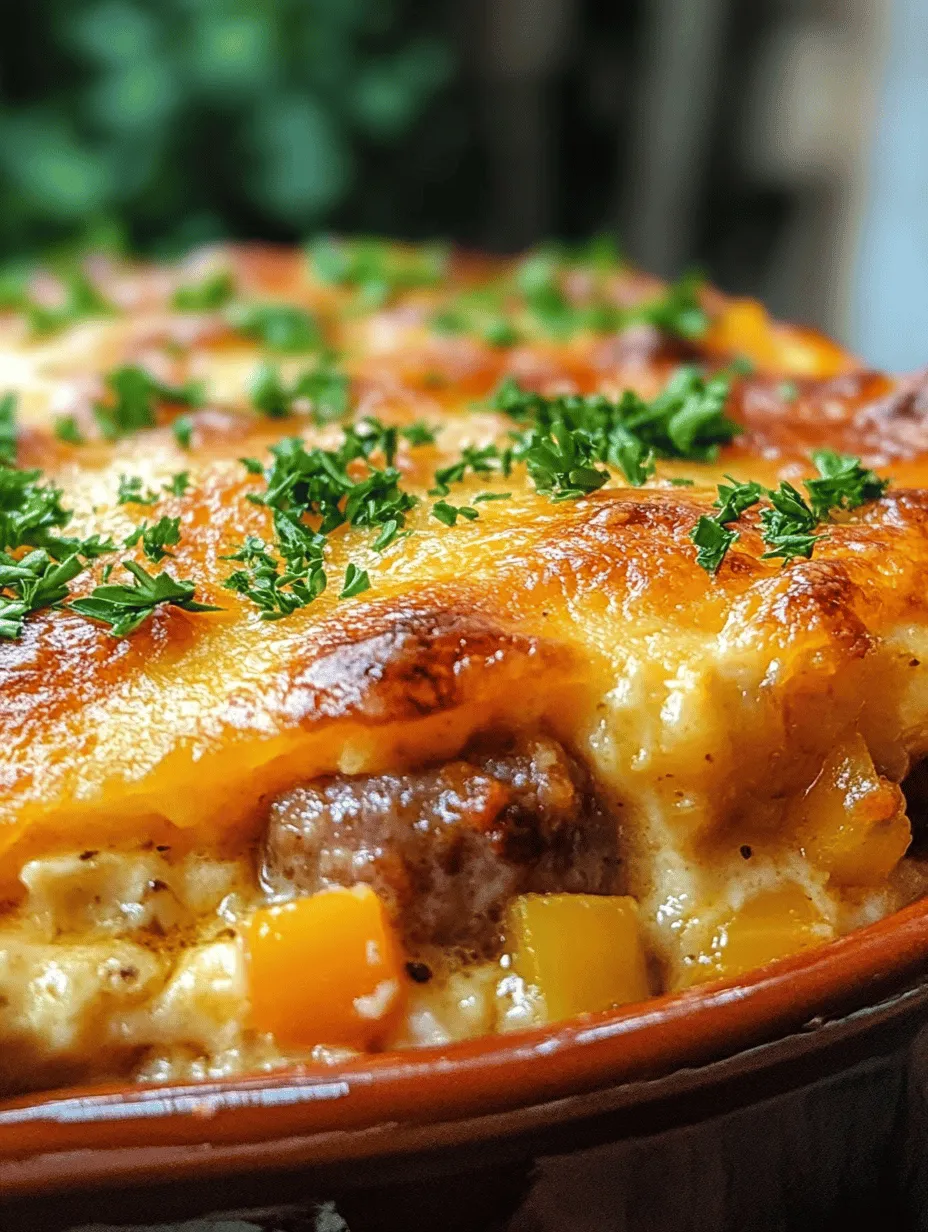Introduction
Amish culture is renowned for its simplicity, community ties, and strong family values, all of which are beautifully reflected in their culinary traditions. One of the cornerstones of Amish cooking is the concept of a hearty breakfast. In a community where hard work and early mornings are the norms, a robust breakfast is not just a meal; it’s a vital part of the day that fuels productivity and brings families together. The tradition of sharing a substantial breakfast resonates deeply within Amish households, where recipes are often passed down through generations, each infused with love and warmth.
One such beloved recipe is the Hearty Amish Breakfast Casserole. This dish epitomizes comfort and family-friendliness, making it a perfect choice for breakfast gatherings, holiday brunches, or even as a satisfying weeknight meal. The combination of savory breakfast sausage, fluffy eggs, and gooey cheese layered over hearty bread creates a dish that is both filling and flavorful. It’s not just about nourishment; it’s about creating memories around the breakfast table, where stories are shared and laughter abounds.
In this article, we will delve into the rich tradition of Amish breakfasts and explore how the Hearty Amish Breakfast Casserole stands out as a quintessential dish. We’ll also break down the essential ingredients that contribute to its delightful taste and texture, and guide you through the initial preparation steps needed to bring this comforting meal to your table.
Understanding the Ingredients
To create the perfect Hearty Amish Breakfast Casserole, it’s essential to understand the role each ingredient plays in crafting this delicious dish. Let’s take a closer look at the key components that come together to make this casserole a family favorite.
Breakfast Sausage: Flavor and Protein Source
One of the star ingredients of this casserole is breakfast sausage. Packed with flavor and protein, sausage serves as the backbone of the dish, providing a savory base that complements the other ingredients beautifully. Whether you opt for spicy, mild, or herb-infused sausage, the choice can greatly affect the overall flavor profile of your casserole. The sausage is typically browned before being mixed with the other components, allowing its juices to seep into the dish and enhance the overall taste.
Bread: Texture and Base for the Casserole
The next crucial element is the bread, which forms the casserole’s base. Traditionally, day-old bread or rolls are used to absorb the flavors of the egg mixture while maintaining a satisfying texture. This ingredient not only adds substance but also acts as a sponge, soaking up the creamy egg and milk mixture, resulting in a casserole that is both hearty and satisfying. Popular choices include white bread, sourdough, or even whole-grain varieties, depending on your preference.
Cheese: Richness and Meltiness
Cheese is another significant component that brings richness and meltiness to the dish. Cheddar cheese is a popular choice for this casserole due to its sharp flavor and excellent melting properties. As the casserole bakes, the cheese melts beautifully, creating a gooey topping that adds depth to each bite. Feel free to experiment with other types of cheese, such as Monterey Jack or Swiss, to customize the flavor to your liking.
Eggs and Milk: Binding and Creamy Consistency
No breakfast casserole would be complete without eggs and milk, which serve as the binding agents that hold the dish together. Eggs provide structure and protein, while milk adds creaminess, making every bite rich and satisfying. Be sure to whisk the eggs and milk thoroughly to ensure an even consistency throughout the casserole. This mixture will envelop the bread and sausage, ensuring that every component is infused with flavor.
Optional Ingredients and Their Benefits
While the core ingredients are essential, there are several optional ingredients that can elevate your Hearty Amish Breakfast Casserole even further. Adding mixed bell peppers not only enhances the dish’s visual appeal with their vibrant colors but also contributes valuable nutrients and a slight crunch. Fresh parsley can be sprinkled on top as a garnish, adding a pop of freshness and flavor that brightens the entire dish.
Preparation Steps Explained
Now that we’ve discussed the key ingredients, let’s dive into the preparation steps that will set you up for a successful and delicious Hearty Amish Breakfast Casserole.
Prepping the Baking Dish and Oven
The first step in preparing your casserole is to ensure your baking dish is ready to go. A 9×13-inch baking dish is typically recommended for this recipe, as it provides ample space for layering all the delicious ingredients. Make sure to grease the dish generously with butter or cooking spray to prevent sticking. This is a crucial step that guarantees easy serving and cleanup later.
Next, preheat your oven to 350°F (175°C). This temperature is optimal for baking casseroles, allowing the ingredients to cook evenly and ensuring the cheese melts to a perfectly gooey consistency.
Cooking the Sausage
While the oven is preheating, it’s time to cook the breakfast sausage. Place a skillet over medium heat and add the sausage, breaking it apart with a spatula as it cooks. The goal here is to brown the sausage thoroughly, which not only enhances the flavor but also ensures that any excess fat can be drained before combining it with the other ingredients.
Techniques for Browning Sausage Effectively
To achieve a nice browning on the sausage, avoid overcrowding the pan. If necessary, cook the sausage in batches to allow each piece enough contact with the pan for proper browning. This will create those flavorful caramelized bits that elevate the dish. Once browned, use a slotted spoon to transfer the sausage to a plate lined with paper towels to drain any excess grease.
Mixing the Egg Mixture
While the sausage is cooking, you can start preparing the egg mixture. In a large mixing bowl, whisk together the eggs and milk until well combined. This step is crucial because it ensures that the mixture is smooth and free of lumps.
Importance of Whisking Eggs and Milk Thoroughly
Thorough whisking helps to incorporate air into the eggs, which will contribute to the casserole’s fluffy texture once baked. Season the mixture with salt, pepper, and any additional spices you desire, such as garlic powder or smoked paprika, to enhance the overall flavor profile.
Layering the Casserole
Now that the sausage and egg mixture are ready, it’s time to layer the casserole. Start by placing the bread cubes evenly across the bottom of the greased baking dish. Next, sprinkle the browned sausage over the bread, distributing it evenly for balanced flavor.
Layering is essential in casseroles, as it ensures that each bite contains a bit of every ingredient. After adding the sausage, pour the egg mixture over the layers, making sure to cover everything adequately. Finally, sprinkle the cheese on top, allowing it to melt beautifully during baking.
Best Practices for Layering Ingredients
When layering the casserole, consider balancing flavors and textures. The bread should provide a sturdy base, while the sausage adds savory depth. The egg mixture binds it all together, and the cheese provides a rich topping.
Refrigeration Time: Why It’s Crucial
After assembling the casserole, it’s beneficial to let it rest before baking. This resting time allows the bread to absorb the egg mixture fully, resulting in a more cohesive texture once baked. You can refrigerate the casserole for at least 30 minutes or, for best results, overnight. This step not only enhances the flavors but also allows for a more satisfying bite.
Overnight vs. Short Rest Options
If you choose to refrigerate the casserole overnight, it can be a game-changer, especially for busy mornings. Simply assemble the dish the night before, cover it with plastic wrap, and place it in the refrigerator. In the morning, all you need to do is remove it from the fridge, uncover, and bake. If time is short, a 30-minute rest at room temperature will still allow the bread to soak up some of the egg mixture, resulting in a delightful casserole.
By following these preparation steps, you’ll be well on your way to creating a Hearty Amish Breakfast Casserole that not only embodies the spirit of Amish hospitality but also delights your family and friends. In the following sections, we will explore additional tips for achieving the best results and answer some common questions about this beloved dish. Stay tuned as we continue our journey into the heart of this comforting breakfast classic.

Baking the Casserole
Once you’ve prepared your Hearty Amish Breakfast Casserole, the next vital step is baking it correctly to ensure that every bite delivers a burst of flavor and goodness. Here’s how to achieve perfect results.
Timing and Temperature for Perfect Results
Preheat your oven to 350°F (175°C). This temperature is ideal for cooking the casserole evenly without burning the top or leaving the insides undercooked. Once your oven reaches the desired temperature, carefully place the casserole dish in the center of the oven. Bake it for approximately 45 to 50 minutes.
Signs to Look For When the Casserole is Done
To know if your casserole is perfectly baked, watch for these signs:
– The edges should begin to pull away slightly from the sides of the dish.
– The center should be set, not jiggly. You can gently shake the dish; if the center remains firm, it’s ready.
– A golden-brown top is a good indicator of doneness, suggesting the eggs have cooked through and the cheese has melted to perfection.
Tips for Achieving a Golden-Brown Top
A golden-brown top is not only visually appealing but also adds a wonderful texture to your casserole. Here are some tips to achieve this:
– Use shredded cheese instead of slices; it melts more evenly and creates that desirable crust.
– For an extra crispy topping, consider broiling the casserole for the last few minutes of baking. Just keep a close eye on it to prevent burning.
– You can also sprinkle a little additional cheese or breadcrumbs on top during the last 10 minutes of baking for added texture and flavor.
Cooling and Serving Suggestions
Once you’ve pulled your casserole out of the oven, let it cool for about 10 to 15 minutes. This resting time allows the casserole to set further, making it easier to cut into neat squares.
When it comes to serving, use a sharp spatula or knife to slice the casserole into squares. Serve it warm, garnished with fresh herbs like parsley or chives for an extra pop of color and flavor.
Importance of Letting the Casserole Rest
Letting the casserole rest is crucial for achieving the best texture. As it cools, the ingredients meld together, and the flavors intensify. This resting period helps prevent the casserole from falling apart when served, allowing for cleaner slices and a more appealing presentation.
Ideas for Garnishing and Presentation
Garnishing your casserole can elevate its presentation. Here are a few ideas:
– Freshly chopped herbs such as parsley, chives, or dill can add brightness.
– A dollop of sour cream or Greek yogurt on top of each serving can introduce a creamy texture.
– Serve the casserole with sliced avocados or fresh tomato wedges on the side for added freshness.
Nutritional Value and Serving Ideas
Understanding the nutritional profile of your Hearty Amish Breakfast Casserole can help you appreciate its health benefits and make informed choices when planning your meals.
Breakdown of Nutritional Information Per Serving
Each serving of this casserole typically contains:
– Calories: Approximately 350-400 kcal
– Protein: 20-25 grams
– Fat: 20-25 grams
– Carbohydrates: 25-30 grams
– Fiber: 2-3 grams
– Vitamins and Minerals: Rich in Vitamin A, Vitamin C, Calcium, and Iron.
These values can vary based on the specific ingredients you use, particularly the type of sausage and cheese.
Suggested Sides for a Complete Breakfast Experience
To round out your breakfast spread, consider pairing your casserole with:
– A simple green salad dressed with a light vinaigrette for freshness.
– Crispy hash browns or breakfast potatoes for added texture.
– Whole grain toast or muffins to complement the dish.
Fresh Fruit Options
Including fresh fruit adds a refreshing sweetness and nutritional balance to your meal. Some excellent options are:
– Sliced strawberries or blueberries for a burst of antioxidants.
– A fruit salad featuring seasonal fruits like melons, oranges, and apples.
– Baked apples or cinnamon-spiced pears for a warm, comforting addition.
Breakfast Beverages That Pair Well
To wash down your Hearty Amish Breakfast Casserole, consider these beverage options:
– Freshly squeezed orange juice or a mixed fruit smoothie for a refreshing start.
– A hot cup of coffee or herbal tea to complement the flavors of the dish.
– For a special touch, serve mimosas or sparkling cider on festive occasions.
Variations and Customizations
One of the best aspects of the Hearty Amish Breakfast Casserole is its versatility. Here are some ideas for variations and customizations to suit different tastes and dietary needs.
Alternative Ingredients for Dietary Restrictions
If you or your guests have dietary restrictions, here are some alternatives:
– Dairy-Free: Use plant-based cheeses and milk alternatives.
– Nut-Free: Ensure no nuts are included in any toppings or garnishes.
– Low-Carb: Replace the bread with a cauliflower base for a low-carb option.
Vegetarian Options: Replacing Sausage with Plant-Based Alternatives
For those looking to enjoy a vegetarian version, substitute the sausage with options like:
– Crumbled tempeh or tofu seasoned with spices for a protein boost.
– Plant-based sausage crumbles available in many grocery stores.
– Sautéed mushrooms, bell peppers, or spinach for added bulk and flavor.
Gluten-Free Variations: Using Gluten-Free Bread
To make a gluten-free version of the casserole, simply replace regular bread with gluten-free bread. There are many brands available that don’t sacrifice flavor or texture.
Flavor Variations to Try
Experimenting with different flavors can keep this dish exciting. Consider:
– Adding spices like paprika, garlic powder, or chili flakes for a kick.
– Incorporating different types of cheese such as feta, goat cheese, or pepper jack for a unique twist.
Incorporating Seasonal Vegetables
Seasonal vegetables can enhance the nutritional profile and flavor of your casserole. Try adding:
– Spinach, zucchini, or asparagus in the spring.
– Sweet potatoes or butternut squash in the fall.
– Tomatoes, bell peppers, or corn in the summer.
Meal Prep and Freezing Tips
This casserole is perfect for meal prep. Here are some tips:
– Assemble the casserole the night before and refrigerate. Bake it fresh in the morning.
– You can also freeze the casserole before baking. Wrap it tightly in foil and store it for up to three months. When you’re ready to bake, thaw it overnight in the fridge and then bake as directed.
How to Store Leftovers Effectively
Leftovers can be stored in an airtight container in the refrigerator for up to four days. For longer storage, consider freezing individual portions in freezer-safe containers for up to three months.
Reheating Instructions for Best Quality
To reheat your leftover casserole, preheat your oven to 350°F (175°C) and cover the dish with foil to prevent it from drying out. Heat for about 20-25 minutes or until warmed through. Alternatively, you can microwave individual servings for 1-2 minutes, ensuring they are heated evenly.
Cultural Significance of the Amish Breakfast
The Amish breakfast is not just about the food; it represents a rich cultural heritage and community values.
Historical Context of Amish Cooking
Amish cooking is rooted in tradition, simplicity, and the use of fresh, local ingredients. The Amish way of life emphasizes self-sufficiency and community, often reflected in their meals, which are hearty and nourishing.
How Community and Family Gatherings Influence Amish Meals
Meals are an essential part of Amish culture, often enjoyed together with family and friends. The Hearty Amish Breakfast Casserole symbolizes this sense of togetherness, providing a filling and comforting meal that brings people to the table.
The Role of Breakfast in Fostering Togetherness
Breakfast is typically a communal meal in Amish households, where families gather to share stories and start their day together. The Hearty Amish Breakfast Casserole embodies this spirit, serving as a warm, inviting dish that encourages conversation and connection.
Conclusion
The Hearty Amish Breakfast Casserole is a perfect blend of flavor, comfort, and tradition. Its rich ingredients and satisfying texture make it an ideal start to any day. Whether you’re hosting a brunch or simply enjoying a weekend breakfast with your family, this casserole is sure to impress.
We encourage you to try this recipe and share it with your loved ones. Embrace the deliciousness of a hearty breakfast, and savor the moments spent around the table. Remember, a good breakfast not only fuels your body but also nourishes your spirit, setting the tone for a wonderful day ahead.



